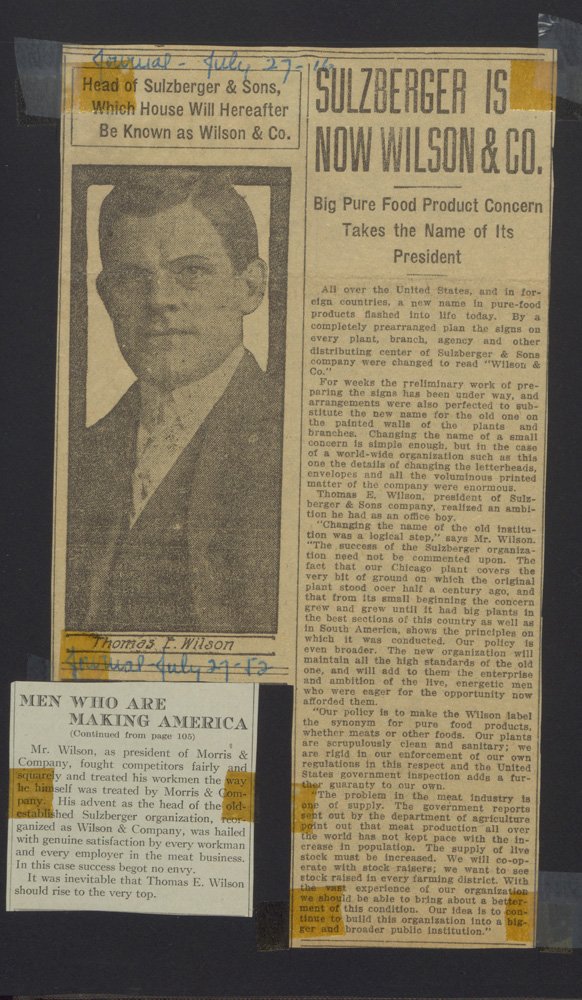The Company
Wilson & Co. evolved over the years to adapt to a changing market and changing leadership. The business began in 1916 when founder Thomas Edward Wilson took control of the Chicago meat packinghouse, Sulzberger & Sons Co., and rebranded it as Wilson & Co. By 1917, the company ranked as one of the 50 largest industrial corporations in the United States, and continued to employ thousands of workers at its plant in Chicago until the 1950s.
Wilson & Co. held several subsidiaries that utilized animal by-products for the manufacture of sporting goods, pharmaceuticals, and industry chemicals. Ashland Manufacturing - a subsidiary of Sulzberger & Sons Co. established in 1913 - manufactured athletic gear under the Thomas E. Wilson brand and became Wilson Sporting Goods in 1931.
View more documents about Wilson & Co.
Timeline of Wilson & Co. History
1916
March 22, 1916
Thomas Edward Wilson is named President of the Chicago meat packing firm Sulzberger & Sons Co. after banks force a change of management. Sulzberger & Sons had been accused of German sympathies when a shipment of meat was intercepted by a British blockade.
July 21, 1916
Sulzberger & Sons Co. is renamed Wilson & Co.
Ashland Manufacturing – a subsidiary manufacturing athletic gear – is renamed Thomas E. Wilson & Co.
1917
Wilson & Co. ranked as one of the 50 largest industrial corporations in the United States.
1927
Thomas E. Wilson’s son, Edward Foss Wilson, enters the family business, starting in the stock yards.
1931
Edward Foss Wilson named Vice President of Wilson & Co.
Subsidiary Thomas E. Wilson & Co. is renamed Wilson Sporting Goods.
1934
February 27, 1934
Edward Foss Wilson is named President of Wilson & Co., and Thomas E. Wilson becomes Chairman of the Board.
1953
Edward Foss Wilson becomes Chairman of the Board of Wilson & Co.
1967
January 5, 1967
Wilson & Co. is acquired by Ling-Temco-Vought, Inc., and its headquarters are transferred from Chicago, Illinois to Dallas, Texas.
Ling-Temco-Vought reorganizes the company into three publicly-traded divisions: Wilson & Co. Inc. (meat), Wilson Sporting Goods Co., and Wilson Pharmaceutical & Chemical Corp.
1969
Wilson Pharmaceutical & Chemical sold to American Can.
1970
Wilson Sporting Goods is acquired by PepsiCo.
Ling-Temco-Vought further subdivides Wilson & Co. Inc. into Wilson Certified Foods, Wilson Beef & Lamb, Wilson Laurel Farms, Wilson-Sinclair, and Wilson Agri-Business Enterprises.
1976
Wilson & Co. is renamed Wilson Foods Corporation.
1981
LTV Corporation (Ling-Temco-Vought) divests itself of Wilson Foods.
1988
Wilson Foods is acquired by Doskocil Companies, Inc.
1989
Amer Group of Finland (later Amer Sports Oyi) acquires Wilson Sporting Goods.
1990
Doskocil files for Chapter 11 bankruptcy and sells off Wilson Brands division.
1995
Doskocil changes its name to Foodbrands America, Inc.
1997
IBP, Inc. acquires Foodbrands America, Inc. (including Wilson Foods).
2001
Tyson Foods acquires IBP, Inc. (along with remaining Wilson meat brands).
2018
A Chinese investor group led by Anta Sports Products acquires a majority stake in Amer Sports Oyj.

Thomas E. Wilson Family Collection, Box 33, Folder 2, Hanna Holborn Gray Special Collections Research Center, University of Chicago Library.
Sulzberger & Sons was the predecessor to Wilson & Co. In this 1914 financial statement, Vice President M. J. Sulzberger reflects upon the effects of WWI on the business. The company was later accused of German sympathies, paving the way for Thomas E. Wilson to take over the company and rebrand it as Wilson & Co.
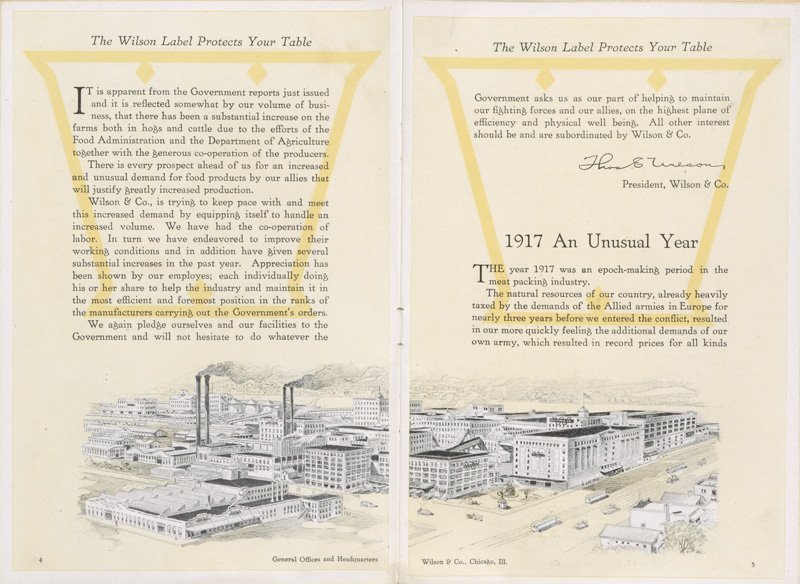
Thomas E. Wilson Family Collection, Box 32, Folder 1, Hanna Holborn Gray Special Collections Research Center, University of Chicago Library.
Three years later, WWI is still impacting the meat packing industry. In this Wilson & Co. annual report, stockholders are informed of the United States Government's control over the business through the Food Administration, beginning November 1, 1917.
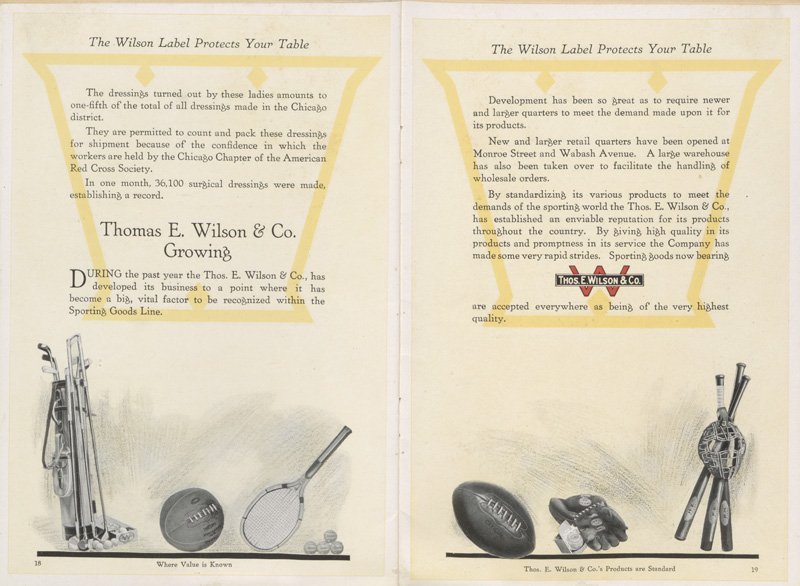
Thomas E. Wilson Family Collection, Box 32, Folder 1, Hanna Holborn Gray Special Collections Research Center, University of Chicago Library.
The 1917 annual report also highlights the booming business of the company's subsidiary, Thomas E. Wilson, & Co., which would later be renamed Wilson Sporting Goods.

Thomas E. Wilson Family Collection, Box 32, Folder 1, Hanna Holborn Gray Special Collections Research Center, University of Chicago Library.
The report highlights a wide range of products produced by Thomas E. Wilson, & Co., including phonographs and ukuleles, sporting and athletic equipment and apparel, bicycles, camping gear, automobile tires and accessories, and gut strings for musical instruments. All made with byproducts of the meatpacking side of the business.

Thomas E. Wilson Family Collection, Box 35, Folder 2, Hanna Holborn Gray Special Collections Research Center, University of Chicago Library.
Print advertisements for Wilson & Co. illustrate the breadth of products offered by the company over the years, including packaged meats, condiments, canned vegetables, eggs, cooking fats, even mattresses stuffed by the "curled hair department."

Thomas E. Wilson Family Collection, Box 33, Folder 21, Hanna Holborn Gray Special Collections Research Center, University of Chicago Library.
Wilson & Co. was prosperous enough to maintain operations across the United States and in Brazil. Here, Wilson & Co. products are being loaded onto the "S. S. Brazil" for her maiden voyage from Santos, circa 1938.

Century of Progress International Exposition Publications, Box 14, Folder 14c, Hanna Holborn Gray Special Collections Research Center, University of Chicago Library.
Wilson & Co. sponsored multiple attractions at the 1933-1934 Century of Progress International Exposition in Chicago. At the Wilson & Co. Exhibit Building on Northerly Island visitors could see an exhibit of the company's varied products, watch bacon being sliced and packaged, and enjoy a meal on the terrace or roof garden. A six-horse team of the company's prize-winning Clydesdales were also on display in the fair's daily historical pageant, "The Wings of A Century" and in the Wilson & Co. stables. Wilson-Western Sporting Goods Co. tennis rackets and golf balls were also advertised at the fair.
View the entire brochure, or see more digitized Wilson & Co. brochures made for the world's fair.

Thomas E. Wilson Family Collection, Box 17, Folder 12, Hanna Holborn Gray Special Collections Research Center, University of Chicago Library.
Edward Foss Wilson is shown standing in the middle of this group photo taken at the Century of Progress International Exposition.

Thomas E. Wilson Family Collection, Box 34, Folder 3, Hanna Holborn Gray Special Collections Research Center, University of Chicago Library.
Illustration showcasing the scale of Wilson & Co.'s business in the United States in 1941, and the refrigerated rail cars and trucks needed to transport Wilson products long distances.
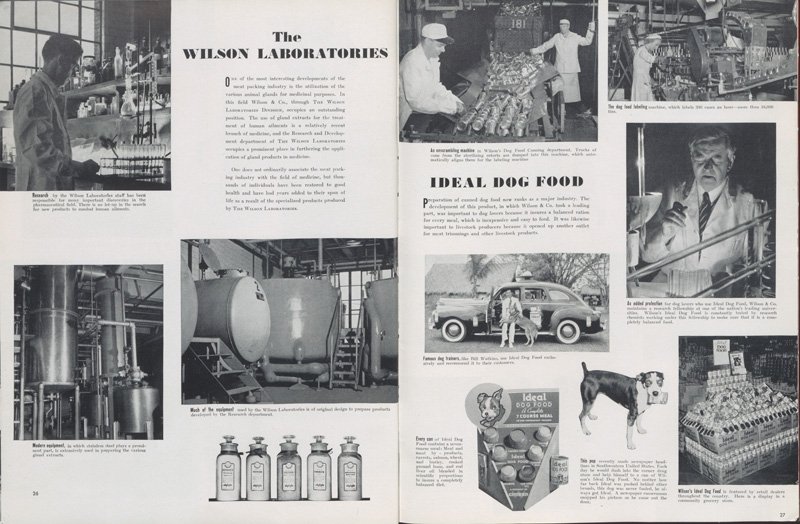
Thomas E. Wilson Family Collection, Box 34, Folder 3, Hanna Holborn Gray Special Collections Research Center, University of Chicago Library.
In addition to foods and sporting goods, Wilson & Co. utilized animal byproducts to produce pharmaceutical products. This company magazine later boasts that they make use of "everything but the squeal."
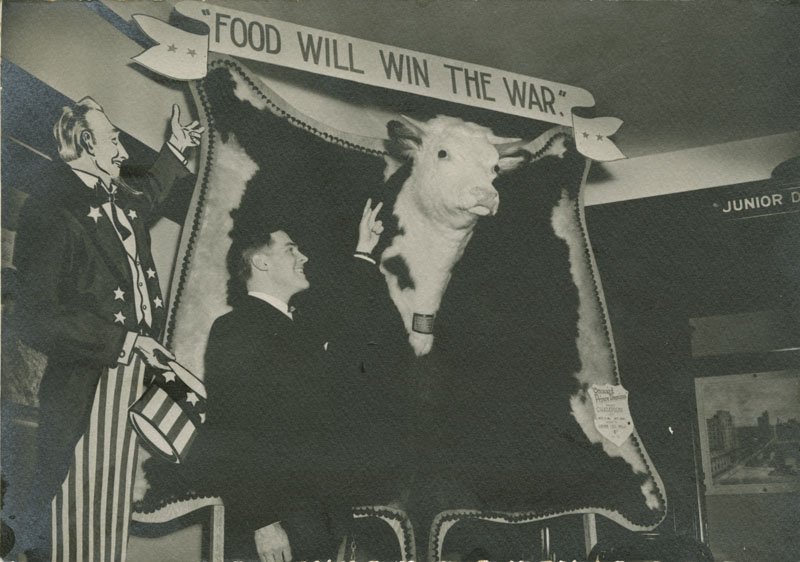
Thomas E. Wilson Family Collection, Box 16, Folder 4, Hanna Holborn Gray Special Collections Research Center, University of Chicago Library.
In the 1940s, Wilson & Co. again played an important role in a world war, developing and supplying canned meats to feed U.S. troops and to aid European relief efforts. Thomas E. Wilson organized the nation's fat salvage campaign following the attack on Pearl Harbor, and was awarded the Medal of Merit for this work in 1946.
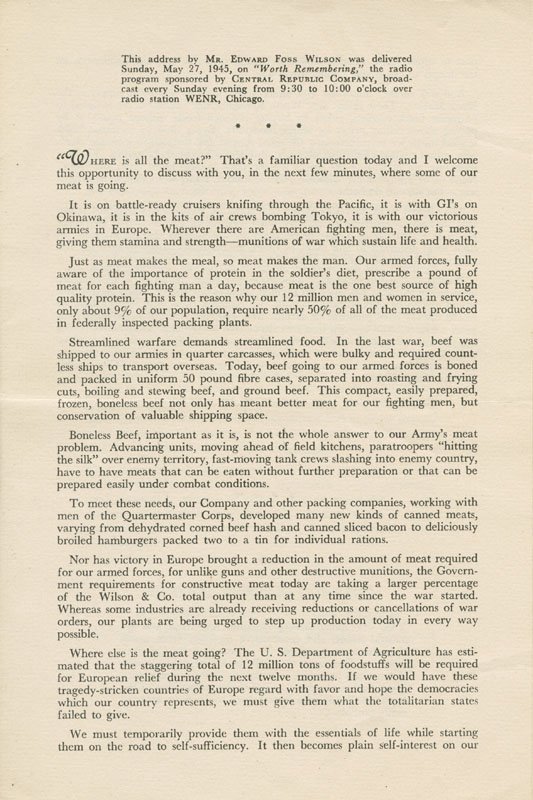
Thomas E. Wilson Family Collection, Box 15, Folder 8, Hanna Holborn Gray Special Collections Research Center, University of Chicago Library.
This address by Edward Foss Wilson was delivered Sunday, May 27, 1945 on "Worth Remembering," a radio program sponsored by Central Republic Company, broadcast every Sunday evening from 9:30 to 10:00 o'clock over radio station WENR, Chicago. In the address, Edward outlined where Wilson & Co. meat products were distributed throughout World War II.
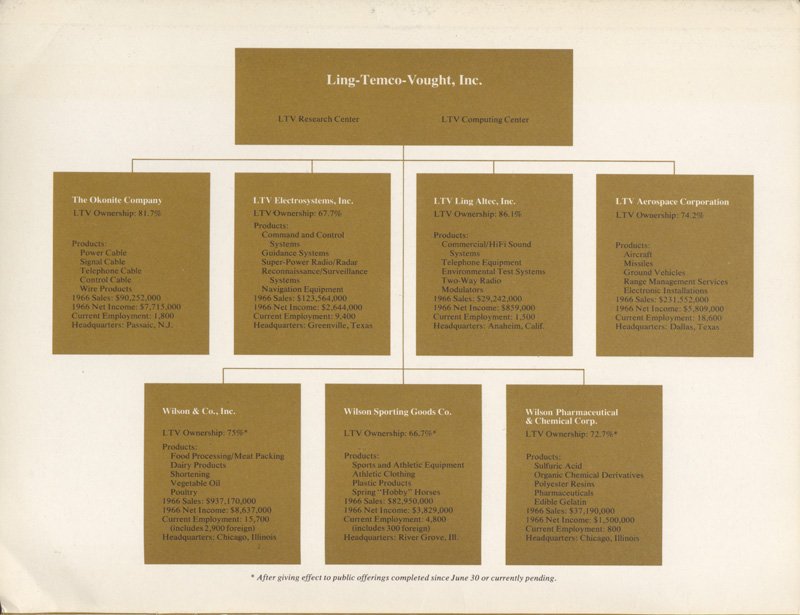
Thomas E. Wilson Family Collection, Box 33, Folder 13, Hanna Holborn Gray Special Collections Research Center, University of Chicago Library.
This organizational chart from a 1967 Ling-Temco-Vought, Inc. report illustrates the reorganization of Wilson & Co. into three divisions: Wilson & Co. Inc. (meat), Wilson Sporting Goods Co., and Wilson Pharmaceutical & Chemical Corp.

Thomas E. Wilson Family Collection, Box 33, Folder 14, Hanna Holborn Gray Special Collections Research Center, University of Chicago Library.
This memorandum to Wilson sporting equipment distributors outlines leadership changes wrought by Ling-Temco-Vought when it acquired Wilson Sporting Goods in 1967.

